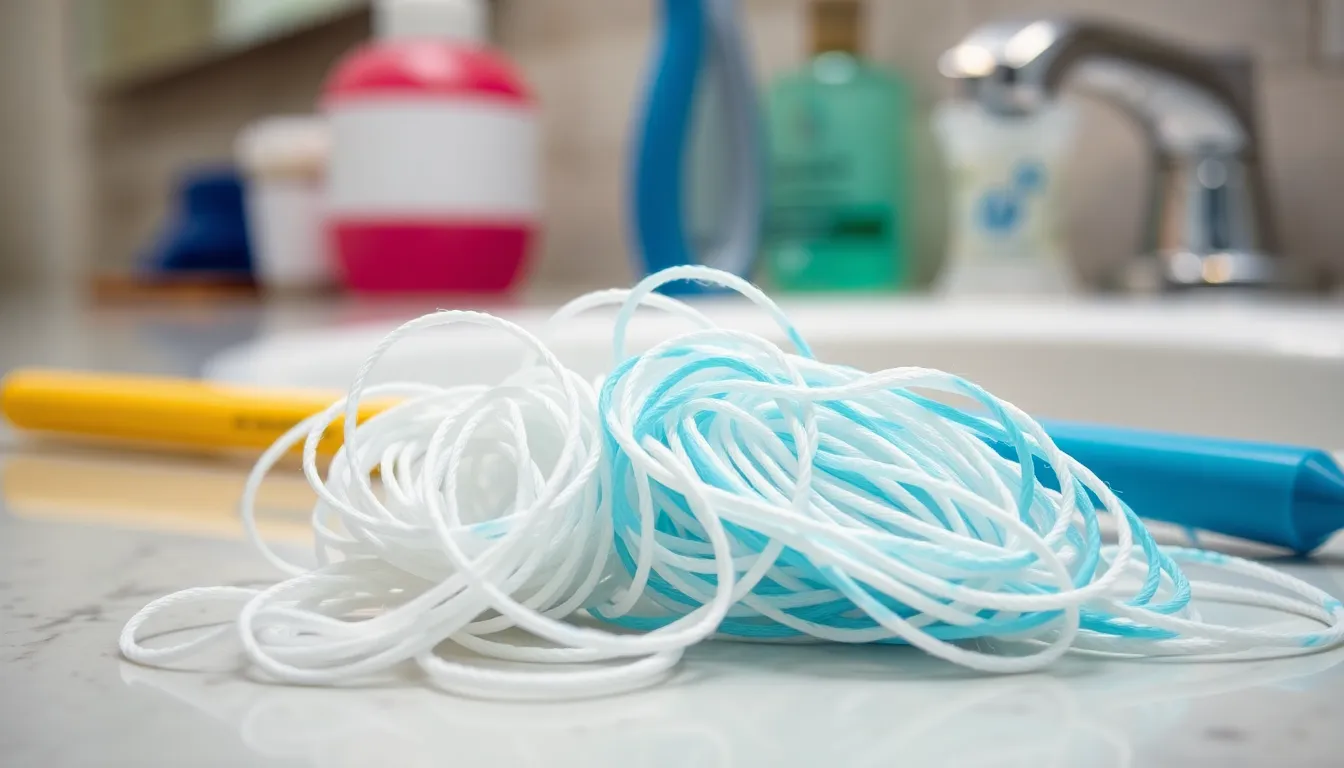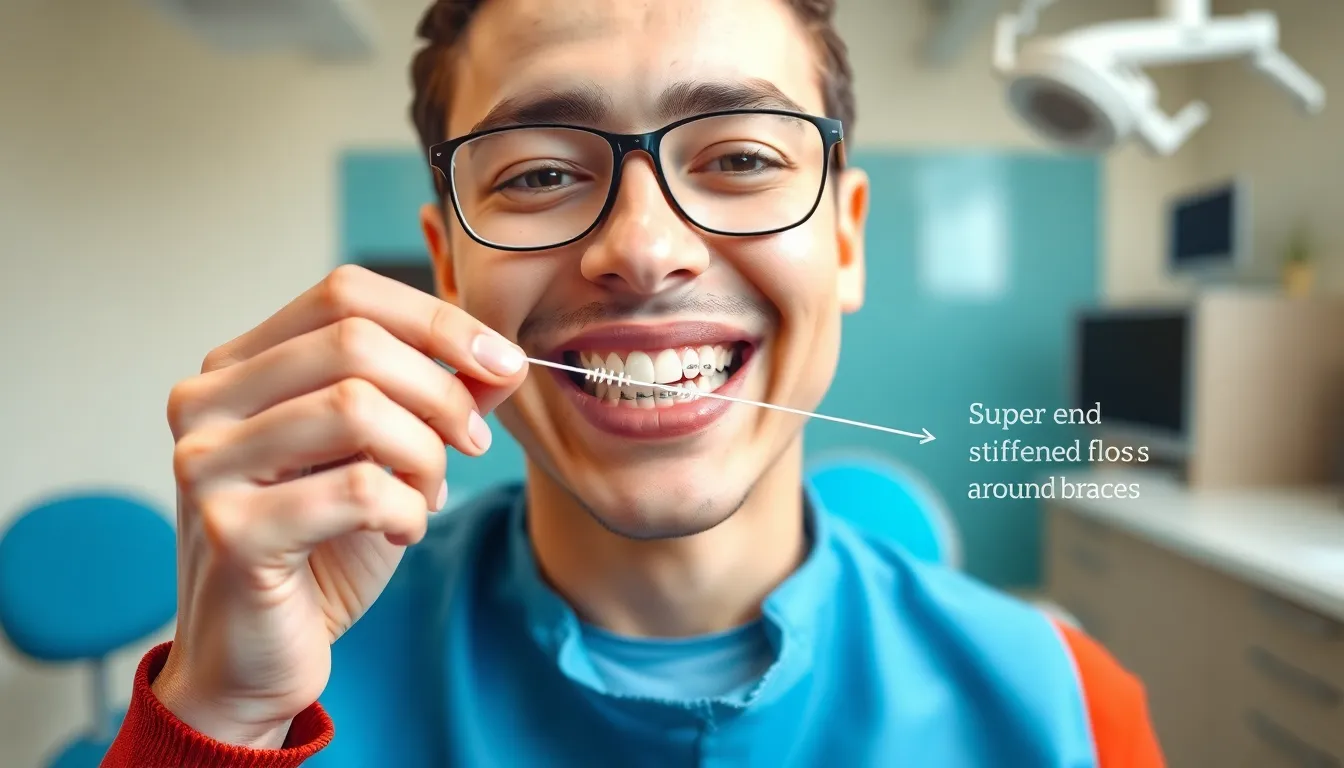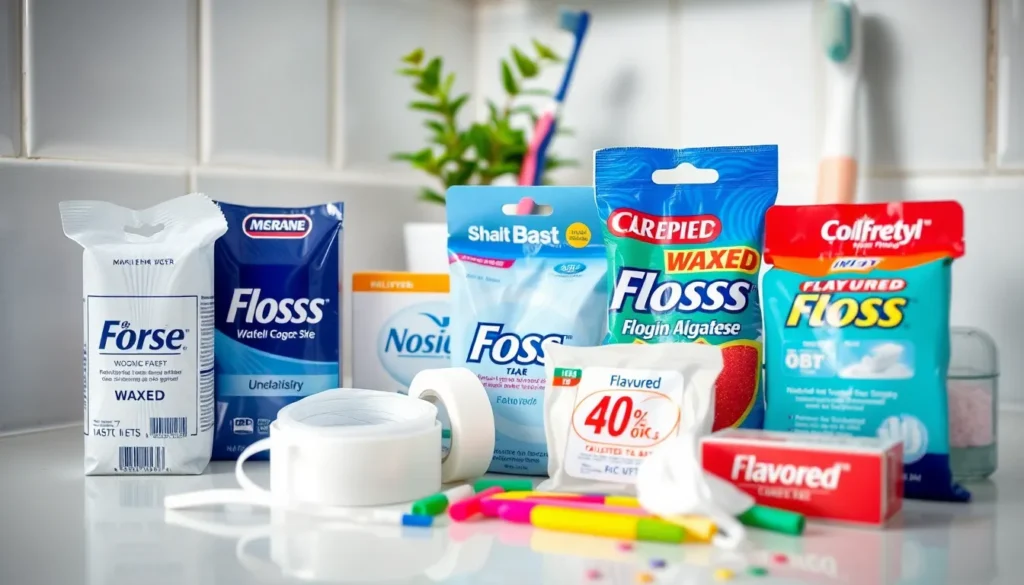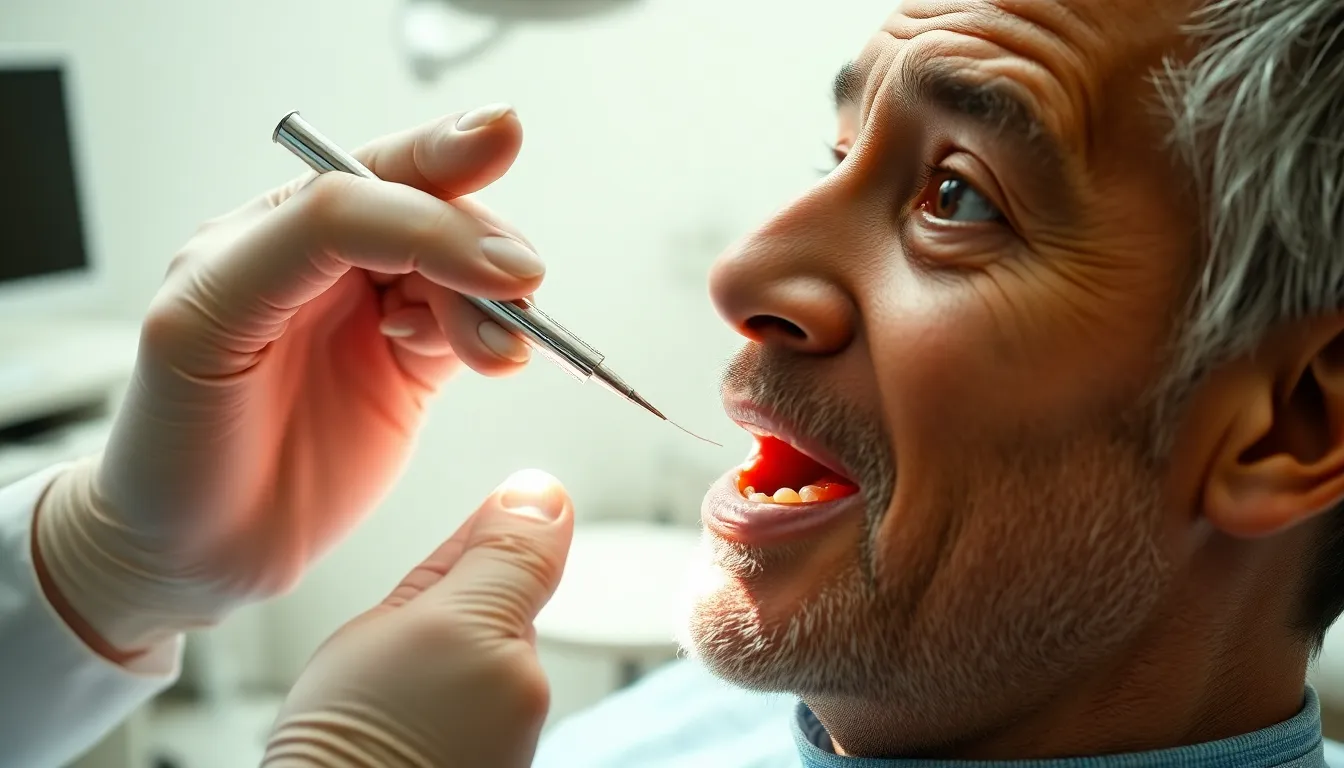Are you confused about which dental floss is right for your oral care routine? With so many options lining store shelves, choosing the perfect floss can feel overwhelming—but it doesn’t have to be.
Dental floss comes in various materials, coatings, and designs, each serving exact needs and preferences. Whether you’re dealing with tight spaces between teeth, have braces, or simply want to make flossing more comfortable, there’s a perfect option for you. Understanding the differences between waxed, unwaxed, tape, and specialized flosses can transform this essential habit from a chore into an effective part of your daily dental care.
What Is Dental Floss and Why Is It Important?
Dental floss is a thin, soft thread made specifically for removing food particles and plaque from between teeth where toothbrushes can’t reach. Most dental flosses are made from nylon filaments or plastic monofilaments (PTFE), with various coatings to enhance glide and effectiveness. Traditional floss comes in a small container with a built-in cutter, while newer versions feature handles or picks for easier access to back teeth.
Daily flossing plays a crucial role in maintaining optimal oral health by removing plaque buildup between teeth. Plaque contains bacteria that produce acids, which attack tooth enamel and lead to cavities over time. These bacteria also cause gum inflammation, resulting in gingivitis and potentially progressing to periodontitis—a serious gum disease that damages gum tissue and can lead to tooth loss.
Dr. Todd B. Harris often shares this story with his patients: “I once had a patient who brushed thoroughly twice daily but never flossed. Even though his diligent brushing, he developed several cavities between his teeth and early signs of gum disease. After incorporating daily flossing for just three months, his gum health dramatically improved, and he hasn’t had a new cavity in the contact areas of his teeth in years. This transformation perfectly illustrates why I emphasize that brushing alone reaches only 60% of your tooth surfaces.”
The American Dental Association recommends flossing at least once daily to remove plaque from areas your toothbrush can’t effectively clean. Research shows that flossing before brushing removes more plaque than brushing first, as it loosens debris that can then be swept away by brushing and rinsing.
Traditional String Floss

Traditional string floss remains the most common type of dental floss, typically made from nylon fibers twisted together to create a strong yet flexible thread. It’s available in two primary varieties: waxed and unwaxed, each offering distinct advantages for different oral care needs.
Waxed vs. Unwaxed Floss
Waxed floss features a light coating that helps it glide more smoothly between teeth, making it less likely to break during use. This variety works particularly well for teeth with larger gaps or when you’re dealing with restorations like fillings or crowns. The slick surface allows it to slide past potential catching points without fraying. Many patients in Dr. Todd B. Harris’s practice prefer waxed floss initially as they find it more comfortable and easier to manipulate.
Unwaxed floss consists of approximately 35 nylon strands twisted together, creating a thinner profile ideal for tight spaces. Its textured surface excels at grabbing and removing food particles and plaque from between closely spaced teeth. Though more prone to shredding than its waxed counterpart, unwaxed floss often provides better cleaning results in tight contact areas. Dr. Harris notes that long-term flossers often transition to unwaxed varieties once they’ve developed proper technique, appreciating the superior cleaning capability.
Flavored Dental Floss Options
Flavored dental floss transforms a mundane oral hygiene task into a more enjoyable experience with options like mint, cinnamon, and various fruit flavors. These pleasant taste additions encourage consistent flossing habits by leaving a refreshing sensation rather than just the clinical feeling of clean teeth.
Mint remains the most popular flavor choice among patients in Dr. Harris’s practice, with many reporting they’re more likely to maintain daily flossing when using flavored varieties. The psychological association between minty freshness and oral cleanliness helps reinforce positive flossing behaviors. Cinnamon flavored options provide a warming alternative for those who find mint too intense, while fruit flavors often appeal to younger patients or those who prefer sweeter notes. These flavor additions don’t impact the effectiveness of the floss itself but can significantly improve compliance with recommended daily flossing routines.
Dental Tape

Dental tape is a broader, flatter alternative to standard dental floss specifically designed for certain oral care needs. It offers unique advantages for people with particular dental configurations and those who find traditional floss uncomfortable or difficult to use.
When to Choose Dental Tape Over Standard Floss
Dental tape shines when you have wider spaces between your teeth where standard floss might feel inadequate or break easily. Its broader surface area provides more effective cleaning by covering more tooth surface with each pass, making it especially valuable for removing plaque and debris from larger interdental spaces. You’ll find dental tape more resistant to shredding compared to unwaxed nylon floss, which can break apart during use in wider gaps.
Many patients report that dental tape feels more comfortable against their gums due to its gentler, ribbon-like structure. Dr. Todd B. Harris recalls a patient with sensitive gums who struggled with regular flossing: “After switching to dental tape, she not only continued flossing daily but also saw a important reduction in bleeding and discomfort. Her gum health improved dramatically within just three weeks.”
Dental tape comes in both waxed and unwaxed varieties, giving you options based on personal preference. The waxed version glides particularly smoothly between teeth, making it an excellent choice for beginners or anyone who experiences discomfort with standard flossing. You’ll appreciate dental tape if you have dental work like bridges or wider gaps where the additional width provides better cleaning contact with tooth surfaces.
Super Floss and Specialty Flosses

Specialty dental flosses address unique oral care challenges that traditional string floss can’t effectively handle. These specialized tools are designed with exact dental conditions and appliances in mind, making oral hygiene more accessible for everyone.
Orthodontic Floss for Braces
Orthodontic floss features a stiffened end section specifically engineered to navigate around brackets and wires. This design allows you to thread the floss between braces and reach areas traditional floss can’t access. Super floss, a popular orthodontic option, comes with three components: a stiff threader end, a spongy section for cleaning wider spaces, and regular floss for normal gaps. Many orthodontists recommend this type of floss to their patients wearing braces because it significantly reduces plaque buildup around brackets.
Dr. Todd B. Harris shares, “One of my teenage patients struggled with maintaining oral hygiene after getting braces. After recommending super floss, we saw a dramatic improvement in her gum health within just two weeks. The stiffened end made it possible for her to clean effectively around her brackets, preventing the white spot lesions that often develop during orthodontic treatment.”
Dental Implant and Bridge Floss
Dental implant and bridge floss features specialized designs to clean around and underneath fixed dental work. These flosses typically include a curved or looped structure that fits perfectly around implants and under bridges where food particles frequently become trapped. Floss threaders work as helpful accessories by guiding regular floss through tight spaces or around dental work, making daily cleaning more thorough and efficient.
Patients with dental bridges particularly benefit from these specialized tools. The space between a dental bridge and gums creates a perfect hiding spot for bacteria that standard brushing can’t reach. Regular use of bridge-exact floss prevents inflammation and extends the lifespan of your dental work.
Floss Picks and Holders

Floss picks and holders offer convenient alternatives to traditional string floss, making daily oral care more accessible for many people. These tools simplify the flossing process and provide better maneuverability, especially for those with dexterity issues or difficulty reaching back teeth.
Single-Use Floss Picks
Single-use floss picks combine convenience and effectiveness in a portable dental tool. These Y-shaped plastic implements feature a short strand of floss stretched between two prongs, creating an easy-to-grip handle that enhances control during flossing. Many patients find these picks particularly helpful for cleaning back molars where traditional flossing techniques prove challenging.
The pre-stretched floss in these picks maintains consistent tension, eliminating the need to wrap floss around your fingers. Their compact size makes them ideal for on-the-go oral care, fitting easily in purses, desk drawers, or car compartments. Dr. Todd B. Harris notes, “I’ve seen remarkable improvement in patients who switched to floss picks after struggling with traditional flossing techniques. One busy executive maintained perfect gum health for years using floss picks during his commute.”
Even though their advantages, these picks have limitations. They don’t allow the floss to curve around each tooth as effectively as traditional methods. The same section of floss is used for all teeth, potentially spreading bacteria from one area to another. Also, single-use plastic picks contribute significantly to environmental waste compared to traditional floss options.
Reusable Floss Holders
Reusable floss holders offer an eco-friendly alternative while maintaining the ergonomic benefits of floss picks. These devices feature a handle with prongs that hold a fresh piece of dental floss, which can be replaced after each use. The design provides excellent control and reach, especially for people with arthritis, limited mobility, or those helping children develop proper flossing habits.
Most reusable holders accommodate any type of dental floss, allowing you to customize your flossing experience based on your exact oral needs. This versatility means you can use waxed floss for wider spaces one day and switch to unwaxed for tighter areas the next. Dr. Harris recommends these holders for patients with manual dexterity issues, saying, “One elderly patient with arthritis regained her flossing independence after trying a reusable holder, dramatically improving her gum health within months.”
The initial investment in a quality reusable holder typically pays off quickly compared to continuously purchasing disposable picks. Maintenance involves simply rinsing the holder after use and replacing the floss segment regularly. Some advanced models feature adjustable tension settings and ergonomic grips for enhanced comfort during daily use.
Water Flossers and Oral Irrigators

Water flossers and oral irrigators represent a technological advancement in interdental cleaning, using pressurized water streams instead of traditional string floss. These devices effectively clean between teeth and below the gumline, making them particularly valuable for people who struggle with conventional flossing techniques.
Benefits of Water Flossing Technology
Water flossers remove plaque and debris with impressive efficiency, often reaching areas that traditional floss might miss. Their pulsating water streams actively reduce gingival inflammation by flushing out bacteria from periodontal pockets. Many users find water flossers significantly easier to handle compared to string floss, especially those with arthritis, limited dexterity, or hand mobility issues.
These devices prove exceptionally effective for cleaning around orthodontic appliances like braces, bridges, and implants where food particles frequently become trapped. Regular use of water flossers can improve gum health by up to 50% more than traditional flossing methods according to clinical studies. The gentle yet thorough cleaning action makes them ideal for patients with sensitive gums or those recovering from dental procedures.
Dr. Todd B. Harris notes, “I’ve seen remarkable improvements in patients who switched to water flossers. One patient with severe gingivitis tried many flossing methods without success. After three weeks of using a water flosser, her gum inflammation decreased dramatically, and bleeding reduced by approximately 70%. The convenience factor simply increased her consistency with daily cleaning.”
Water flossers come in countertop models that connect to electrical outlets and portable versions powered by batteries, accommodating different lifestyle needs and travel requirements. Most modern units offer adjustable pressure settings, allowing users to customize the intensity based on their comfort level and exact oral health needs. The addition of specialized tips for different purposes—orthodontic tips, periodontal tips, and tongue cleaners—enhances their versatility as comprehensive oral care tools.
Eco-Friendly and Biodegradable Floss Options
Environmentally conscious dental care products have emerged as sustainable alternatives to traditional plastic-based options. Biodegradable floss, made from natural materials like silk or plant-based fibers, naturally decomposes after disposal, significantly reducing landfill burden compared to nylon or PTFE flosses. These eco-friendly options maintain effective plaque removal while aligning with environmental values.
Natural wax coatings represent another sustainable advancement in dental floss technology. Many eco-friendly brands use beeswax or candelilla wax instead of synthetic varieties, providing smooth gliding action between teeth without harmful environmental impacts. These natural waxes break down naturally in the environment, creating a complete biodegradable flossing solution.
Plastic-free packaging complements the sustainability of eco-friendly floss products. Compostable containers and recyclable packaging materials minimize waste further, creating a comprehensive approach to reducing dental care’s environmental footprint. Several brands now offer glass containers or cardboard packaging that can be repurposed or recycled.
Dr. Todd B. Harris notes, “I’ve seen a remarkable increase in patients asking about sustainable dental products. One patient switched to silk-based biodegradable floss and reported that it felt gentler on her gums while still effectively removing plaque. She appreciated maintaining her oral health without contributing to plastic pollution.”
Selecting biodegradable floss options supports both personal oral health and broader environmental goals. You’ll find these sustainable alternatives available in many health food stores, specialized dental shops, and online retailers, making them increasingly accessible for everyday use. The effectiveness of these natural options rivals traditional floss types, providing the same cleaning power without the long-term environmental impact.
How to Choose the Right Dental Floss for Your Needs
Selecting the perfect dental floss depends primarily on your exact oral health situation and personal preferences. Your teeth spacing significantly impacts which floss type works best—if you have tight teeth, unwaxed floss or PTFE floss navigates narrow spaces more effectively. Individuals with wider gaps between teeth benefit from dental tape’s broader surface area for maximum plaque removal.
Those with sensitive gums often find waxed floss or dental tape provides a gentler experience while still effectively cleaning between teeth. Braces, bridges, or implants require specialized options like super floss or PTFE floss that can clean thoroughly around dental hardware without getting caught or shredding.
Convenience factors may influence your choice, with floss picks offering an easy option for on-the-go flossing or for those who struggle with traditional flossing techniques. Water flossers present an excellent alternative for people with dexterity issues or extensive dental work.
Dr. Todd B. Harris notes, “I’ve seen remarkable improvements in patients who match their floss type to their exact dental needs. One patient with extremely tight contacts struggled with flossing until switching to PTFE floss—their gum health improved dramatically within just three weeks.”
Environmental considerations might guide your decision toward biodegradable options made from silk or natural fibers if sustainability matters to you. Flavor preferences play a role too—mint, cinnamon, or fruit-flavored flosses can make the daily habit more enjoyable and increase compliance.
Remember that consistency trumps floss type—using any dental floss daily delivers better results than using the “perfect” floss inconsistently. Experimentation with different varieties helps identify which option feels most comfortable and effective for your unique dental structure.
Conclusion
Choosing the right dental floss doesn’t have to be overwhelming. Whether you opt for traditional string floss waxed or unwaxed dental tape specialized varieties for braces and bridges or modern alternatives like water flossers there’s a perfect match for your unique oral needs.
Remember that the best dental floss is eventually the one you’ll use consistently. Your teeth spacing gum sensitivity and dental work all play crucial roles in determining which option will work best for you.
Don’t hesitate to experiment with different types until you find your ideal match. Your dentist can provide personalized recommendations based on your exact oral health situation. With the right floss and daily use you’ll be well on your way to maintaining optimal oral health for years to come.
Frequently Asked Questions
What is dental floss and why is it important?
Dental floss is a thin thread designed to remove food particles and plaque from between teeth where toothbrushes can’t reach. It’s typically made from nylon or plastic monofilaments. Daily flossing is crucial for preventing plaque buildup, which can lead to cavities and gum disease. The American Dental Association recommends flossing at least once daily, ideally before brushing, to maximize plaque removal and enhance overall dental hygiene.
What’s the difference between waxed and unwaxed floss?
Waxed floss is coated with a thin layer of wax that helps it glide smoothly between teeth and makes it less likely to break, making it ideal for larger gaps and dental restorations. Unwaxed floss has a thinner profile that excels in tight spaces between teeth and is often preferred by experienced flossers for its superior cleaning ability.
What is dental tape and who should use it?
Dental tape is a broader, flatter alternative to standard dental floss designed for individuals with wider spaces between teeth. Its broader surface area provides more effective cleaning and is more resistant to shredding. Many users find dental tape more comfortable against their gums due to its gentler, ribbon-like structure. It’s available in both waxed and unwaxed varieties and is particularly effective for those with dental work like bridges.
What options are available for people with braces?
People with braces can use specialized orthodontic floss, which features a stiffened end to navigate around brackets and wires. Super floss is a popular option that combines a stiff threader end, a spongy section for wider spaces, and regular floss for normal gaps. These specialized flosses significantly reduce plaque buildup around braces and can dramatically improve gum health for orthodontic patients.
Are water flossers effective compared to traditional floss?
Water flossers are highly effective for interdental cleaning, using pressurized water streams to clean between teeth and below the gumline. They’re particularly valuable for individuals who struggle with conventional flossing techniques. Water flossers often reach areas that traditional floss might miss and can significantly improve gum health, especially for those with sensitive gums or dental appliances.
What are eco-friendly floss options?
Eco-friendly floss options include biodegradable floss made from natural materials like silk or plant-based fibers, which decompose after disposal while maintaining effective plaque removal. These sustainable alternatives often use natural wax coatings, such as beeswax or candelilla wax, and come in plastic-free, compostable, or recyclable packaging to minimize environmental impact.
How do I choose the right dental floss for my needs?
Choose your floss based on your teeth spacing, gum sensitivity, and dental work. For tight teeth, use unwaxed or PTFE floss; for wider gaps, try dental tape. If you have sensitive gums, waxed floss or dental tape may be gentler. Those with braces or implants should consider specialized options like super floss. If you have dexterity issues, floss picks or water flossers might be more convenient. The most important factor is consistency in your flossing routine.
Can floss picks replace traditional dental floss?
Floss picks offer convenience and portability, making them helpful alternatives to traditional string floss, especially for those with dexterity issues. However, they have limitations—the short strand of floss between prongs may spread bacteria around the mouth, and they offer less flexibility in cleaning techniques. While not a perfect replacement, floss picks are still beneficial for daily oral care and are better than not flossing at all.







